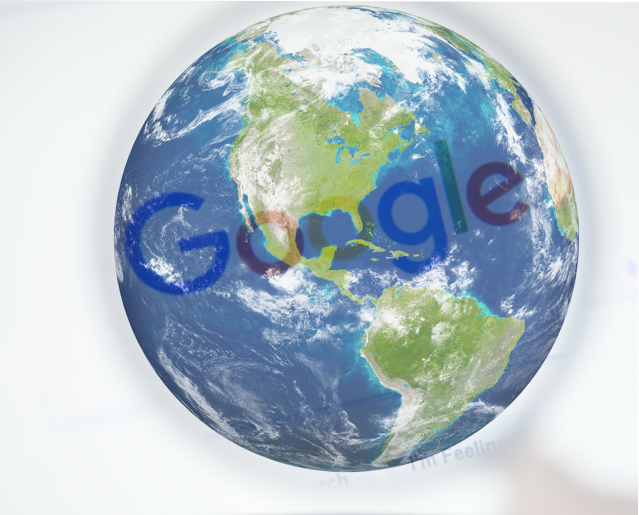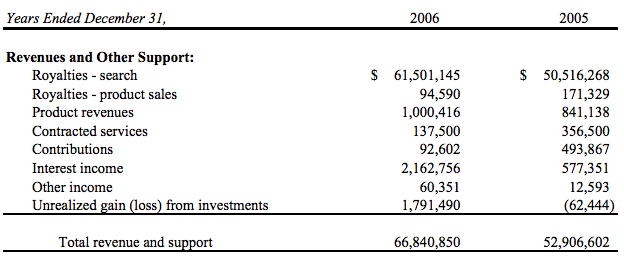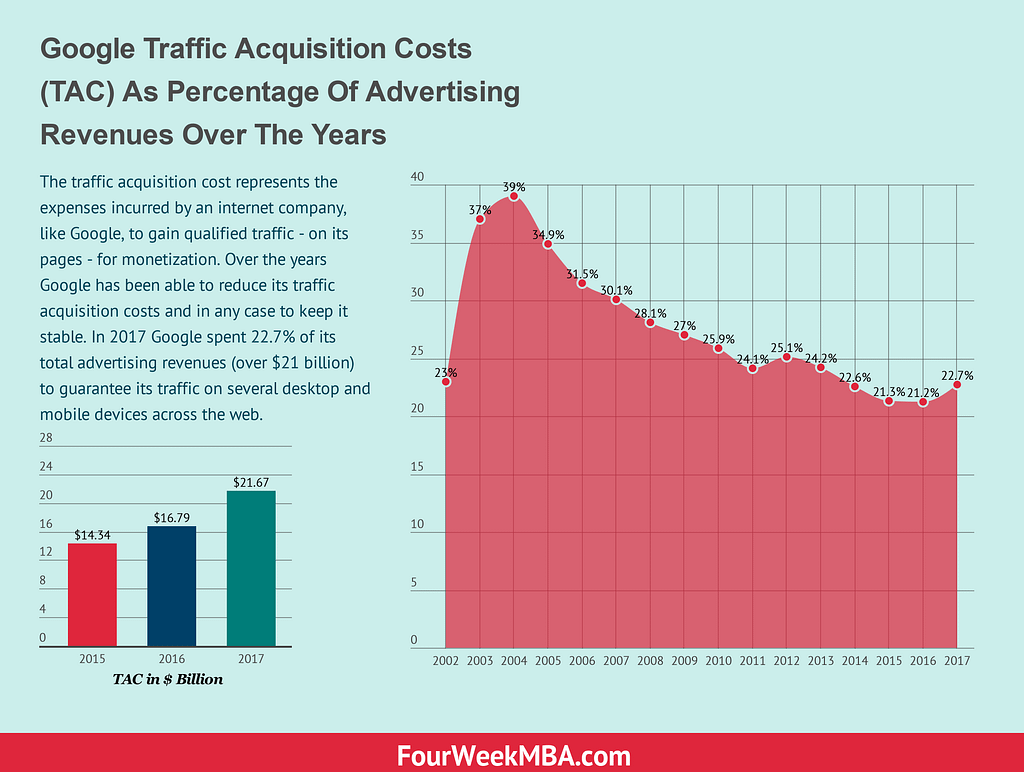Latest news about Bitcoin and all cryptocurrencies. Your daily crypto news habit.

When we think of Google, that’s easy to think of it as the most significant tech success of the last decades. Yet, Google isn’t only that. Google is the most significant tech, distribution and commercial success of the previous decades. Indeed, the company managed to conquer the web and build an over a hundred billion a year turnover based on digital advertising alone based on a brilliant distribution strategy, built one deal at the time!
Considering it was a late mover, I believe that part of the secret for its success was the deals it managed to close, which allowed it to gain traction and traffic for years to come. As I pointed out in another article, the traffic acquisition cost strategy that Google put up over the years, allowed the company to create a sustainable business model that keeps making money today.
Thus, it is worth exploring some of the deals that made Google the success it is today!
Netscape deal: the first massive deal
MOUNTAIN VIEW, Calif. — October 4, 2000 — Google Inc., developer of the award-winning Google search engine, and Netscape Communications, a subsidiary of America Online, Inc., (NYSE: AOL), today announced that they have renewed their partnership under which Google will continue to provide the fall-through search technology to complement Netscape’s award-winning Open Directory Project (www.netscape.com). Netscape will also continue to feature Google as a Premier Search Provider as part of its popular Net Search Program, which helps Netscape users choose from a variety of different search tools available on the Web.
This is how Google announced the news back then.
What was the deal about?
First, it is worth to remember that Netscape at the time was the most successful and trafficked browser on the web. That might have been the period in which Netscape was the web. Indeed, most of the browser market was in its hands. It is important to notice that Google at the time had proved a reliable service for Netscape users, which made it easier to close that deal. Therefore, the product or service is always a key ingredient in a business deal success.
As pointed out at the time “Netscape was the first to realize the potential of Google’s cutting-edge search technology, and we are pleased to continue our relationship, which underscores our commitment to providing the best possible search tools to navigate the Web.“
Google deal with Mozilla to keep getting search market shares
Google understood that if it wanted to have a sustainable business model, it needed a continuous stream of traffic so that it could monetize that traffic on its main asset, its search results pages. Yet back in the 2000s Google was still far from having its web browser, Chrome, which would be launched in 2008. In the meanwhile, if it wanted to dominate the market, it had to secure deals across the board of the browser market.
Mozilla was one critical piece of the puzzle and Google made it a good deal for them. Back then of the $61 million in royalties most came from Google’s deal:
Source: Mozilla Independent Auditor’s Report
As pointed out on TechCrunch back then:
Mozilla,the organization behind the popularFirefoxweb browser, has extended its search deal withGooglefor another three years. In return for setting Google as the default search engine on Firefox, Google pays Mozilla a substantial sum — in 2006 the total amounted to around $57 million, or 85% of the company’s total revenue. The deal was originally going to expire in 2006, but was later extended to 2008 and will now run through 2011.
Guarantee the proper distribution to your product or service is a commercial war. Thus, you need to have a compelling offer. Google managed to secure the deal for years, thanks to its offer, which made up most of Mozilla revenues for years!
When Microsoft tried to steal AOL deal, Google went all in!
As we’ve seen one of the key deals that allowed Google a proper distribution success was Netscape. Yet, Netscape was acquired by AOL in 1998 for a staggering $4.2 billion. Back when AOL was the most popular portal on the web. Being there for Google was critical. Microsoft understood that, and it offered AOL a compelling deal:
Google has been the search engine on AOL for several years, but rival Microsoft Corp. made a bid to take its place, offering AOL hundreds of millions in cash annually if it dumped Google for MSN Search. But Thursday night in New York, Google presented Richard D. Parsons, chief executive of AOL parent Time Warner Inc., with a more lucrative proposal that gave AOL numerous ways to grow along with rapidly expanding online ad spending.
As reported on the Washington Post of the time battle between Microsoft and Google was quite fierce. Google relaunched the Microsoft offer with a deal that would be hard to refuse.
As pointed out by the Washington Post “Under the agreement, Google will remain the search engine on the AOL service for five years, and Google will give AOL millions of dollars of free advertising on the search engine to promote its network of Web sites.“
Also, “AOL also will get the exclusive right to sell online banner ads for Google. AOL will keep about 20 percent of the proceeds from those ad sales, while Google will get about 80 percent.“
To give you a bit of context of how critical this deal was, AOL at the time had 20 million subscribers and 110 million unique visitors per month. As part of the deal, Google also bought 5% of the company for a billion dollar.
As pointed out on Google financials for 2006:
We rely on our Google Network members for a significant portion of our revenues, and we benefit from our association with them. The loss of these members could adversely affect our business.
To understand the importance of AOL for Google distribution success, “advertising and other revenues generated from America Online, Inc. (“AOL”) accounted for 12%, 9% and 7% of revenues, primarily through our AdSense program, in 2004, 2005 and 2006.“
A single deal, AOL, accounted for more than 10% of Google revenues in 2004. And this traffic wasn’t inexpensive neither. Indeed, throughout 2003–06 there was an increase in traffic acquisition costs ($135.5 million) primarily driven by advertiser fees generated through the Google AdSense program.
Google needed to become independent and start building up its distribution channel via its browser. While its toolbar was already available beginning in 2000, Google Chrome was yet to come. In the meanwhile, Google wanted to get more distribution capability to dominate the market!
Google deal with the once mighty Ask.com
In 2007 Google secured another essential deal with a search engine that at the time was quite popular, Ask.com. As pointed out on SEJ:
Yesterday Google and IAC (the parent company of Ask.com) extended their sponsored search and advertising agreement in a move which is worth an estimated $3.5 Billion to IAC over the next 5 years.
Microsoft stole AOL deal to Google when it was too late
Over the years Microsoft had tried to take several deals from Google, unsuccessfully. Finally, in 2016 Microsoft managed to secure a deal with AOL, for its search engine, Bing. At that point, the deal couldn’t do any harm to Google dominance over the search market!
Yet the fight for the conquest of distribution on the web isn’t over.
Originally published at fourweekmba.com on October 23, 2018.
The Deals That Made Google The Tech Giant We Know Today was originally published in Hacker Noon on Medium, where people are continuing the conversation by highlighting and responding to this story.
Disclaimer
The views and opinions expressed in this article are solely those of the authors and do not reflect the views of Bitcoin Insider. Every investment and trading move involves risk - this is especially true for cryptocurrencies given their volatility. We strongly advise our readers to conduct their own research when making a decision.

